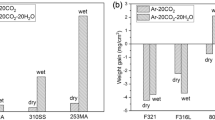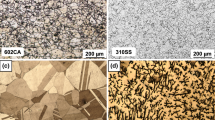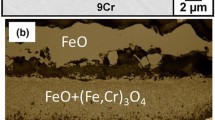Abstract
Cobalt alloys containing up to 25% chromium have been exposed to Ar-10% SO2 atmospheres at temperatures between 600 and 1000° C. The results show that, although an increase in chromium content leads to a reduction in the reaction rate, even to negligible rates in the cases of the higher chromium contents, all of the alloys are eventually subjected to rapid attack at more or less longer times, depending on the chromium content. The mechanism of the reaction appears to involve the formation of a more or less protective oxide layer which is eventually penetrated by sulfur. The sulfur forms chromium sulfides at the metal-scale interface, removing the chromium from solution and causing an expansion that cracks the protective scale, allowing both the ingress of gas and the formation of rapidly growing cobalt compounds. The process occurs rapidly with Co-5% Cr alloys, whereas, only the initial sulfur penetration is observed with Co-25% Cr alloys during the time scale of the investigation. The penetration of sulfur is thought to occur as a molecular gas species permeating through the scale down physical defects.
Similar content being viewed by others
References
C. A. Phalnikar, E. B. Evans, and M. M. Baldwin,J. Electrochem. Soc. 103, 429 (1956).
I. G. Wright and G. C. Wood,Oxid. Met. 11, 163 (1977).
S. K. Verma, D. P. Whittle, and J. Stringer,Oxid. Met. 5, 169 (1972).
El. Dahshan, J. Stringer, and D. P. Whittle,Oxid. Met. 8, 211 (1974).
T. Flatley and N. Birks,J. Iron Steel Inst., London 209, 523 (1971).
M. R. Wootton and N. Birks,Corros. Sci. 12, 829 (1972).
P. Singh and N. Birks,Oxid. Met. 12, 23 (1978).
N. Tattam, PhD thesis, Univ. of Sheffield (1968).
R. P. Salisbury and N. Birks,J. Iron Steel Inst., London 209, 534 (1971).
M. R. Wootton and N. Birks,Corros. Sci. 15, 1 (1975).
F. S. Pettit, J. A. Goebel, and G. W. Goward,Corros. Sci. 9, 903 (1969).
N. Birks, inSymposium: Properties of High Temperature Alloys, Z. A. Foroulis and F. S. Pettit, eds. (Electrochem. Soc., 1978), p. 215.
N. Birks, “High Temperature Gas-Metal Reactions in Mixed Environments,” Transaction of The Metallurgical Society, A.I.M.E., Boston, S. A. Jansson and Z. A. Foroulis, eds. (May 1972), p. 322.
A. Rahmel and J. A. Gonzales,Werkst. Korros. 22, 283 (1971).
Author information
Authors and Affiliations
Rights and permissions
About this article
Cite this article
Singh, P., Birks, N. The attack of Co-Cr alloys by Ar-SO2 atmospheres. Oxid Met 13, 457–474 (1979). https://doi.org/10.1007/BF00605110
Received:
Issue Date:
DOI: https://doi.org/10.1007/BF00605110




